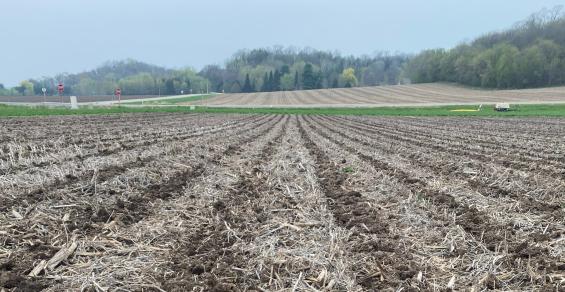Field Fodder: Conventional-tillage practices increase soil compaction and erosion.
Tillage, in a sense, has been part of the fabric of American agriculture since the beginning. If farming is to be successful over the long-term though, we must focus on mimicking the biological nature of the ecosystem on farms.
Far from harmonizing with nature, conventional-tillage practices increase soil compaction, stunt the soil microbiome and make soils vulnerable to severe erosion.Choosing to reduce soil disturbance by practicing conservation-tillage strategies such as strip tillage or no-till can be an effective way to increase farm resilience by restoring effective soil structure, encouraging healthy soils and mitigating severe soil erosion.
By comparing a field in conservation tillage for 24 years with a similar field in conventional tillage, researchers found that the density of the topsoil in the conservation-tillage field was less dense than in the conventional-tillage field, which was compacted. Because the soil structure was not densely compacted in the conservation-tillage field, over twice as much water infiltrated the soil profile there, compared to the conventionally tilled field. For farmers in the business of harvesting natural resources to grow crops, some extra water can make all the difference in a dry year.
Encouraging healthy soils
There are roughly 1,500 to 15,000 pounds of microorganisms — including critters like fungi, bacteria, protozoa and earthworms — present per acre of soil. On the upper end, that would be the equivalent of having one Tyrannosaurus rex on each acre of farmland. Unlike an extinct T-rex though, these soil microorganisms are very much alive and play an integral role in the soil by cycling nutrients and restoring soil structure.
So, how does conventional tillage negatively affect them?
Take fungi, for example. Fungi grow as a network in the soil, linking soil aggregates to build fundamental soil structure and sharing a symbiotic relationship with plant roots in nutrient cycling. Consider it almost as a massive, invisible underground spiderweb linking the soil together and providing innumerable biological benefits to the soil and crops. When soil is tilled, this “spiderweb” gets destroyed. The soil dries out, stunting beneficial fungi growth, and the fungi is not able to supply the benefits it does when the soil is left undisturbed. Reducing soil disturbance by practicing conservation tillage encourages beneficial fungi growth in the soil profile, which becomes the backbone of healthy soil structure and promotes the flourishing of the soil microbiome.
Mitigating severe erosion
A study done between 2016 and 2018 in the U.S. found that a field practicing conventional tillage in a corn-soybean rotation lost 10.2 tons of soil per acre per year to erosion, on average. A similar field that practiced conservation tillage in a corn-soy rotation lost only 1.8 tons of soil per acre per year to erosion, on average. Excessive tillage causes severe soil erosion and poses the issue of losing topsoil at a rate faster than it can be rebuilt.
If a soil loses 10 tons of topsoil per acre per year to erosion, it has lost about the thickness of a quarter in one year across an acre. After losing soil at this rate for 15 years, 1 inch of topsoil will have been lost to erosion. “OK,” you might say, “so we start practicing soil conservation, and in a few years, we will have that 1 inch of topsoil back, right?” Not quite. Natural processes do build topsoil, but you won’t see a 1-inch increase in topsoil for about 500 years. Conservation tillage decreases the severity of soil erosion on farmland to protect the topsoil we have left but does not necessarily make new soil.
In conclusion, practicing conservation-tillage strategies such as strip tillage or no-till on farms will work to restore effective soil structure; encourage a healthy, living soil; and prevent severe soil erosion, providing numerous conservation benefits and increasing farm resilience. The work of agronomists and farmers, once again, can harmonize with the natural resources we are stewards of and the organisms we are co-workers with.
Geissinger is a regional University of Wisconsin Extension crops educator.




